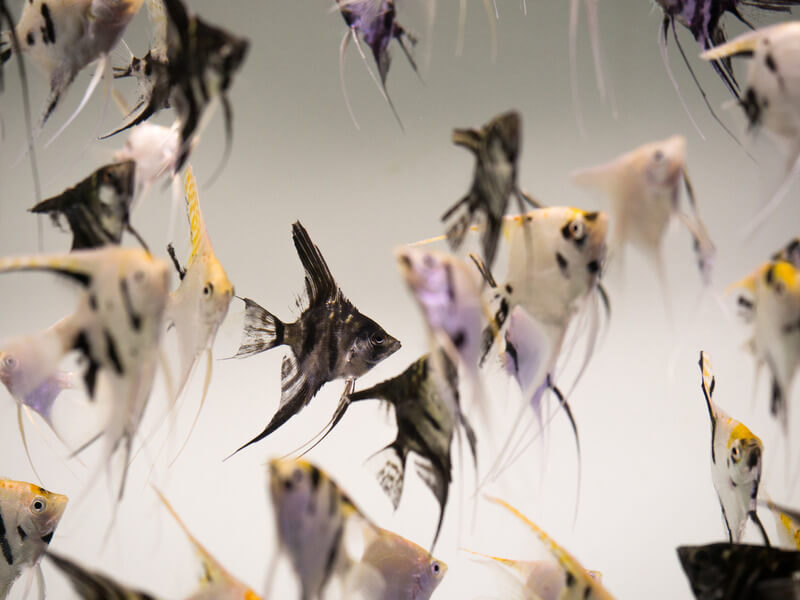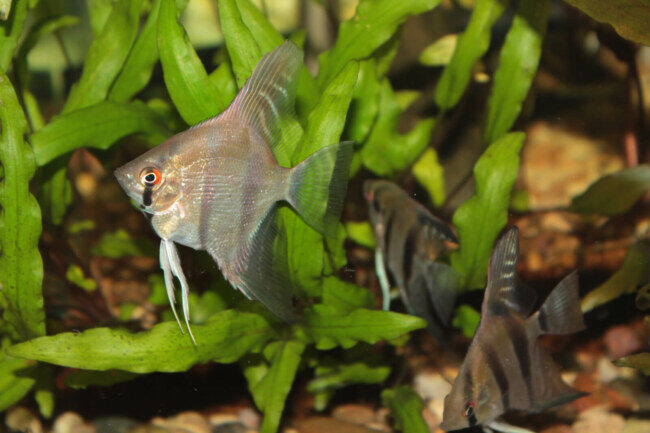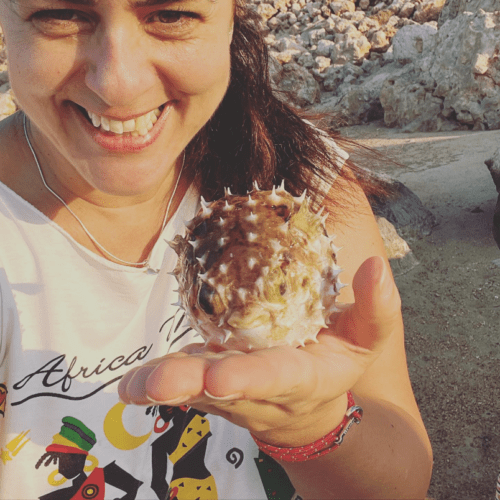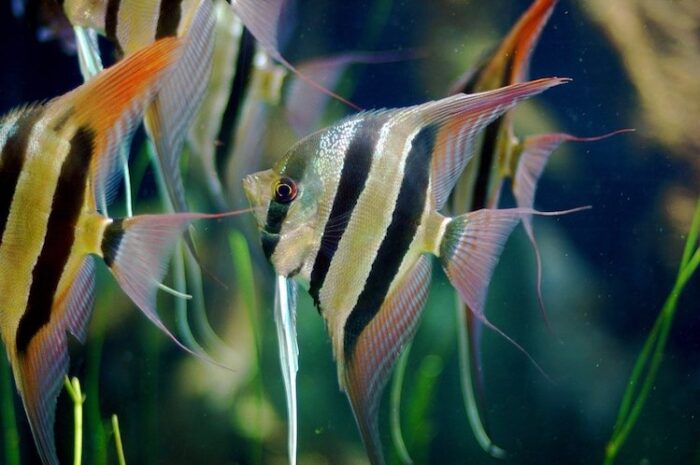The angelfish isn’t one to be fine in any old tank. So what tank size do I need for an angelfish? The recommended size for one angelfish is 10 to 20-gallons. But to keep your fish happy there is a lot more to consider. Such as the shape, how many fish you have in the tank with them, and yes, the size.
The benefits of the correct tank size should not be underestimated. The size of an angelfish’s aquarium contributes to how large they get, their general health and will determine their behavior towards any other companions they might have.
It’s instrumental for a happy angelfish and when you meet their needs you can get a glimpse into sometimes playful nature. To best accommodate their requirements you first need to understand their make-up.
Read further to get a glimpse of why a larger tank is necessary, the minimum aquarium size needed, and other accommodations necessary for your angelfish to be happy.
Table of Contents
Understanding the angelfish
To get the right tank for your angelfish, first, you need to understand them. Their size, who they cohabitate well with, and where they are originally from. Angelfish are great to have when the right conditions are meet and the beginning of that is getting the correct tank.
Even though they are an easy-going breed, as long as you have correct conditions, they do have specific needs as far as the room goes. Part of that is due to their shape and overall size.
The aquarium size is also important for community tanks and the angelfish’s overall behavior towards their tankmates. Thankfully, the aquarium setup for the freshwater angelfish isn’t complicated, but knowing some things now will make your life easier, overall.
A healthy angelfish will get large
Not only will they get large they grow in height rather than length. Looking at one you will see a tall fish that flat. While most fish grow in length as well as height, the angelfish will grow in height rather than length.
In the wild your freshwater angelfish will grow to be at least 10 inches, they can grow to that height in captivity. However, you will need a large tank with only a few fish. Typically if you have a community fish tank the most your angelfish will get is 6 inches in height.
Their size came to an advantage while in the wild. Since they are on the larger size in a smaller environment they had very few predators. While being flat they can sneak into crevices to get algae.
Larger tanks combat aggression
Your freshwater angelfish is naturally accustomed to lakes and ponds in South America, even though they have been bred in captivity since the late 1920s, this length of time has changed their parenting habits which are non-exist in captive angelfish.
This time, however, has done little to change their preferences for their space and current. If you have more fish simply you need more space.
They are used to having their territory and if there isn’t a lot of space to be had they will make sure everyone knows that what little there is theirs. Smaller tanks or tanks with lots of fish will cause them to lash out at everyone including their species.
So even if there are recommendations for their size if you can afford it, the larger the better.
Angelfish do better with larger numbers of their kind
Being alone is not healthy for the angelfish. Even though they have a reputation of being aggressive they still want to be with those of their kind. Otherwise, the singular angelfish can exhibit aggressive behavior towards its tankmates.
The recommended gallon amount for the angelfish is just 20 for one fish. However, in the wild, they aren’t a solitary creature. They move around in shoals of the same species both for protection and help finding food.
If they are alone or in small numbers they will pick on other fish or event ones in their same species. Owning an angelfish is easy, preparing for them is the tricky part.
At the very least get a pair so that they will have someone of the same species, but if you can, get up to 6. You will find that their typical defensive behavior will calm down.
So when getting an aquarium to think about how you want the result of your tank will be. If you plan on adding to your angelfish population then get a bigger tank now. We show you exactly what tank size and shape you need.
If you get multiple angelfish you should also read our following articles. They will help you to set up everything correctly so that you do not lose any of your fish.
The best tank for your angelfish
Most of the struggle with an angelfish is setting up the right conditions for them to live peacefully. One of the first things that you will need to consider for your fish is the aquarium.
Not only is it where it will spend it’s days, but also the dimensions of the tank will make it a more content fish for those who are around it. Getting the wrong tank size for your angelfish could lead to lethargy and/or aggression in your fish.
A lot of the aggressive reputation that the angelfish has is tied to the size of their aquarium. This could be because the aquarium is less than the recommended size or because they have more tankmates than they would like.
The angelfish like to have their own space even if the tank has other inhabitants. If they don’t get that space they will bully the other fish for it. Some of the bulling will be obvious like biting or hitting other fish with their fins.
Other aggressive behavior such as producing chemical signals to the other fish in their waste will be less clear. If you find that your other fish shy away from the same areas that you angelfish inhabit or are hiding from them entirely it’s time to upgrade your tank size.
Below are a few things to look out from when buying your tank. Before purchasing think about what you want your set up to look like at completion. If you contemplate that now it will be easier for you, overall.
Tank size
Angelfish are happier in a larger environment. So even if there are tank recommendations if it is within your budget opt for the largest tank you can get. This is especially true if you plan on getting multiple fish.
They tend to be territorial, a smaller space that they have to share will bring that out and you could lose a couple of other fish.
Thankfully, there are standard guidelines to follow for the tank size. The standard recommended size for one angelfish is a 20-gallon tank. If you plan on getting more than one each additional angelfish will need 10-gallons.
Even though they are a shoaling fish they need their own space, even with those of the same species. You will use the additional 10 gallons for every additional angelfish that you bring into the tank.
To break this down for two angelfish you would need a 30-gallon tank, for 3 angelfish a 40-gallon, for 4 angelfish a 50-gallon, and so on.

Tank shape
Part of the angelfish’s appeal is their proportions, they don’t grow long or even very wide, but they do grow in height. Due to the dimensions of the angelfish a taller tank is better than those that provide a lot of width.
At the very least your tank should be 18 inches high. If you can get a 20-inch tank that would be better.
Why larger is better
The freshwater angelfish socially are shoaling, meaning they spend time together social but do not swim in the same direction such as a schooling fish would.
The impact on your tank size is this, angelfish are less aggressive with a group of peers and they like their individual space to search for food.
With a larger tank, you can use décor or plants to split the space between them. They will still be able to swim all over the tank, but it will give them their own space.
This idea only works if you have two angels together, any more than that and it will be difficult for you to accommodate this idea.
The Marine angelfish setup
While they are not as common as the freshwater angelfish you can keep a marine angelfish as a pet. The saltwater angelfish has 86 species within its family so make sure to research your particular fish for the best tank size and environment.
That being said the majority of marine angelfish are reef dwelling creatures. They typically live in shallow water rarely living more than 20 meters deep.
The saltwater angelfish’s diet is a reflection of the environment that they live in coral, algae, and various smaller invertebrates that come along.
The reason that freshwater and marine angelfish are often confused with each other is due in part to their similar looks. They both come in beautiful colors and patterns, though the saltwater angelfish has much more of a variety.
Their similar shape and habitat, the marine angelfish also like to hang out on the edges, contribute to similar tank setups. There are a few differences, the saltwater angelfish needs a much larger tank.
Their natural environment is the coral reef and there is also the saltwater aquarium to deal with.
Tank size also matters to the marine angelfish. The smaller species can be housed in a 50-gallon tank. If you plan to get a medium to large angelfish, go get the 100-gallon tank.
The marine angelfish is beautiful and comes in a variety of colors and patterns, but to keep them you need to upgrade to a saltwater tank. Specifically for the saltwater angelfish, you need a reef saltwater tank.
A lot of the same tank qualities that the freshwater angelfish need is the same for the marine species.
Saltwater tanks
If you are thinking of making the change to the saltwater aquarium there are a few things to understand beforehand. The set up for a saltwater tank will be more expensive than a freshwater one.
Things like salt, live rock, and powerhead are needed for the marine aquarium that isn’t for your typical freshwater one.
There is a lot more thought that needs to go in a saltwater tank as far as compatible species goes. The ocean’s terrain is a lot more varied than you would find in freshwater rivers and lakes.
You will need to first focus on the type of saltwater aquaria such as reef, live rock with fish, or fish only. Then the process of choosing compatible fish within these types of environments.
Most people who make the change to a marine aquarium start with the fish only variety then move into either a live rock or reef tank. Depending on what you keep in your tank the marine tank isn’t too complex on upkeep, but it isn’t one that someone should start with.
Current in your freshwater angelfish tank
Something else to consider about the angelfish setup besides the tank is the current level in your aquarium. In the wild, the freshwater angelfish’s natural habitat are ponds, lakes, and slow-moving streams.
Even when they are found in rivers they will spend time together on the edges where the water is less swift. Their body is adjusted to this style of swimming. They typically stay in the middle of the tank and float around.
Luckily, the freshwater angelfish don’t need a complicated setup, different from the saltwater angelfish which is a distinct species. But the current that flows through the water is something that you need to pay attention to.
Think about the environment they naturally live in. They prefer calmer waters so they can just cruise about.
You can test to see what level they prefer. I wouldn’t set it to high at first, start at a medium flow. High flow in your fish tank could exhaust them to the point where they just stay in one place.
If you notice that initially, they enjoy the unsteady waters watch to see if they continue to like it. Sometimes angelfish will respond positively to a higher stream then grow exhausted with the effort needed to swim.
The angelfish will give a few tale tail signs that the flow of water is too high for them. The symptoms of too high of a current are hiding, lethargic, and aggression.
If you notice them staying only where there is a blind spot in the stream or hiding completely then it could be because the current from your filtration is too high. All of the things that you are trying to fight by getting them a bigger thank.
You might think that it would be better, yet some sort of filter is necessary for the overall health of the aquarium. They have a healthy appetite so as a result, they need a filter to clean out the inevitable waste that will come.
Even if your filtration system is too high of current for your angelfish you don’t have to replace it. There are a few ways you can reduce the flow of current in your tank.
- Décor of assorted sizes
- Plants, real or plastic
- Move the output nozzles in a different direction
To use these methods efficiently think about the angelfish’s habits. The angelfish tend to swim in the middle of the tank. The idea is to block the currents from where you angelfish is typical hangs out.
That way your filter is still moving the water, but your fish are unhindered from swimming where they want.
Décor like caves force the water to move around it creating bubbles of still space where your angelfish can cruise. Plants near the filter, whether real or fake, don’t block the flow of water, but they will soften it to a speed that your angelfish can easily swim in.
You can also move the nozzle of your filtration system to places that you know your angelfish don’t go. Play with these methods and see works best for your angelfish.
Like with most breed information, it is a commonality between the species as a whole, but it doesn’t mean that your particular fish will act this way. Some cats like to swim, dogs that don’t like attention, and angelfish that like a high current.
Pay attention to your fish’s habits instead of going by secondhand information. You will get a better understanding of what is best for them.
As far as fish go the angelfish don’t require a ton of adjustments for them to live an enjoyable life. That’s why great for beginners who want to start with and are beautiful enough to please those who have taken care of fish for a long time.

Marta, the driving force behind WaterWorldCraze.com, holds a Master’s degree in Marine Biology and has extensive experience in water sports and activities. With over 7+ years of hands-on experience in marine research and conservation, she has participated in numerous underwater expeditions and projects. Her passion for the aquatic world shines through in her expertly curated content. Join Marta as she explores the wonders of marine life and shares her adventures. Connect with her on Instagram @marinebiologymarta for more insights and updates.

